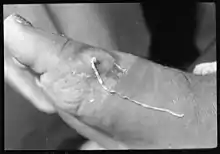蠕虫病
蠕虫病,也称为蠕虫感染,是人和其他动物一部分身体被寄生蠕虫感染导致的一种巨噬细胞疾病。这些寄生虫种类很多,大致分为絛蟲、吸蟲和线虫。它们通常生活在宿主的胃肠道中,但也可能钻入其他器官,引起生理损伤。
| 蠕虫病 | |
|---|---|
_(16424840021).jpg.webp) | |
| X射线图像,以钡作为造影剂,显示南非某感染者小肠中的蛔虫(一种蠕虫) | |
| 类型 | 寄生虫病、疾病 |
| 肇因 | 感染 |
| 分类和外部资源 | |
| 醫學專科 | 傳染病學 |
| ICD-11 | 1F90 |
| ICD-9-CM | 120-129.99、128.9、128.8 |
| DiseasesDB | 28826 |
土源性蠕虫病和血吸虫病是最重要的蠕虫病,属于被忽视热带病[1]。2012年,世界领先的制药工程和非政府组织共同启动了一项名为“被忽视热带病伦敦宣言”的项目,旨在到2020年控制或根除某些被忽视的热带病[2]。
目前已发现蠕虫病会导致婴孩产出不良、认知发育不良、学业和工作表现不佳、社会经济发展不良以及贫困[3][4]。其它次要影响包括慢性病、營養不良和贫血[5]。
迹象和症状
蠕虫病的症状取决于许多因素,包括感染部位、蠕虫类型、蠕虫数量、蠕虫体积、伤害类型、免疫反应等。如果身体供给物质和能量给寄生虫的负担很轻,则可能没有任何症状。某些蠕虫可能会导致特定的症状,例如绦虫可导致癫痫发作[7]。

临床照片示例:几内亚蠕虫感染(麦地那龙线虫病),蠕虫从感染者的脚下钻出
_(15806559913).jpg.webp)
由于蛔虫的感染导致腸系膜破裂
质量和体积
在肠道感染的极端情况下,蠕虫的质量和体积如过大则可能导致肠壁外层(例如肌肉层)撕裂,进而可能导致肠道腹膜炎、肠扭转和坏疽[8]。
流行病学
死亡
每年有多达135,000人死于土源性蠕虫病[3][11][12]。
1990至2013年全球疾病负担研究估计血吸虫病直接致死人数为5,500人[13],而2013年估计有超过20万人死因与血吸虫病有关[14]。此病另外还对2000万人造成严重后果[15],是被忽视热带病中最致命的一种[16]。
| 蠕虫属 | 俗名 | 每年感染者数(百万) | 每年直接致死者数 | 多发区域 |
|---|---|---|---|---|
| 土源性蠕虫病(属于被忽视热带病): | ||||
| Ascaris lumbricoides | 线虫 | 807至1,121[17] | 20,000 | 东南亚、非洲、中美洲和南美洲多地[18][19][20][21][22][23] |
| Trichuris trichiura | 鞭蟲 | 604至795[17] | 亚洲、非洲、中美洲、南美洲和加勒比岛屿的潮湿、温暖、热带地区[20][21][22][23][24] | |
| Ancylostoma duodenale | 钩虫 | 576至740(一般意义上的钩虫)[25] | 热带和亚热带国家(撒哈拉以南的非洲地区)[21][24] | |
| Necator americanus | ||||
| Strongyloides stercoralis | 钩虫、蟯蟲 | 50至100 | 数千人 | 热带和亚热带潮湿多雨地区,以及南欧、东欧和美洲部分地区[21][22] |
| 所有土源性蠕虫病 | 1500至2000[6] | 135,000[3][11][12] | 热带和亚热带地区,尤见于撒哈拉以南的非洲、美洲、中国和东亚[6] | |
| 不通过土壤传播,但属于被忽视热带病: | ||||
| Schistosoma mansoni | 血吸虫 | 所有血吸虫总计:160至200
(210人“受影响”[26]) |
12,000[27](150,000人死于肾功能衰竭[28]
200,000人死因与血吸虫病有关[14]) |
热带和亚热带地区[20][21][22][23][24] |
| Schistosoma haematobium | 112(仅撒哈拉以南的非洲)[28] | |||
| Echinococcus granulosus | 3[29] | 发展中国家 | ||
| 不通过土壤传播,也不属于被忽视热带病: | ||||
| Toxocara canis | 狗线虫 | 50 | 东南亚、非洲、中美洲和南美洲多地[18][19][20][21][22][23] | |
| Taenia solium | 猪肉绦虫 | 50 | 南美洲、东南亚、西非和东非[20][21][22][23] | |
| Taenia saginata | 牛肉绦虫 | 50 | ||
| Hymenolepis nana | 侏儒绦虫 | 100 | ||
| Hymenolepis diminuta | 鼠绦虫 | |||
| Fasciola hepatica, Fascioloides magna |
肝吸虫 | 50 | 主要分布与南亚和东亚,但也见于中欧和东欧[21][22] | |
| Fasciolopsis buski | 巨型肠吸虫 | |||
| Dracunculus medinensis | 几内亚蠕虫 | 由于根除计划,如今可以忽略不计[30] | 曾在印度、西非和苏丹南部广泛分布[21][22] | |
| Trichostrongylus orientalis | 线虫 | 1至3 | 亚洲农村[21][22] | |
| 其它 | 100 | 全球[21][22] | ||
| 总计(感染人数) | 约35亿 | 全球 | ||
参考资料
- . cdc.gov. 2011-06-06 [2014-11-28]. (原始内容存档于2014-12-04).
- London Declaration. (PDF). 2012-01-30 [2013-03-26]. (原始内容存档于2012-10-31).
- Report of a WHO Expert Committee (1987). Prevention and Control of Intestinal Parasitic Infections (页面存档备份,存于). World Health Organization, Technical Report Series 749.
- Del Rosso, Joy Miller and Tonia Marek (1996). Class Action: Improving School Performance in the Developing World through Better Health and Nutrition (页面存档备份,存于). 世界银行, Directions in Development.
- WHO. . World Health Organization Technical Report Series. 2012, 972 (972): 1–174. PMID 23420950.
- . Fact sheet N°366. 2015-05 [2015-06-30]. (原始内容存档于2018-04-18).
- Del Brutto OH. . The Scientific World Journal. 2012, 2012: 1–8. PMC 3261519
 . PMID 22312322. doi:10.1100/2012/159821.
. PMID 22312322. doi:10.1100/2012/159821. - Madiba T. E.; Hadley G. P. . South African Journal of Surgery. February 1996, 34 (1): 33–5; discussion 35–6 [2016-02-13]. PMID 8629187. (原始内容存档于2017-02-24).
- Minciullo P. L.; Cascio A.; David A.; Pernice L. M.; Calapai G.; Gangemi S. . European Review for Medical and Pharmacological Sciences. 2012, 16 (11): 1513–1518. PMID 23111963.
- John DT, William Jr AP. . Saunders Elsevier Press. 2006. ISBN 0721647936.
- Lustigman S.; Prichard R. K.; Gazzinelli A.; Grant W. N.; Boatin B. A.; McCarthy J. S.; Basáñez M. G. . PLOS Neglected Tropical Diseases. 2012, 6 (4): e1582. PMC 3335854
 . PMID 22545164. doi:10.1371/journal.pntd.0001582.
. PMID 22545164. doi:10.1371/journal.pntd.0001582. - Yap P.; Fürst T.; Müller I.; Kriemler S.; Utzinger J.; Steinmann P. . Journal of Visualized Experiments. 2012, 66 (66): e3966. PMC 3486755
 . PMID 22951972. doi:10.3791/3966.
. PMID 22951972. doi:10.3791/3966. - Naghavi, M.; Wang, H.; et al. . The Lancet. 2015, 385 (9963): 117–171 [2019-06-14]. ISSN 0140-6736. PMC 4340604
 . PMID 25530442. doi:10.1016/S0140-6736(14)61682-2. (原始内容存档于2021-03-10).
. PMID 25530442. doi:10.1016/S0140-6736(14)61682-2. (原始内容存档于2021-03-10). - Thétiot-Laurent, S. A.; Boissier, J.; Robert, A.; Meunier, B. . Angewandte Chemie International Edition in English. 2013-06-27, 52 (31): 7936–56. PMID 23813602. doi:10.1002/anie.201208390.
- Kheir M. M.; Eltoum I. A.; Saad A. M.; Ali M. M.; Baraka O. Z.; Homeida M. M. . American Journal of Tropical Medicine and Hygiene. February 1999, 60 (2): 307–10. PMID 10072156. doi:10.4269/ajtmh.1999.60.307.
- . cdc.gov. 2011-06-06 [2014-11-28]. (原始内容存档于2014-12-08).
- . Centers for Disease Control and Prevention (CDC). 2013-01-10 [2014-12-20]. (原始内容存档于2021-03-26).
- Blanca Jiménez (2006) Irrigation in developing countries using Wastewater (页面存档备份,存于), International Review for Environmental Strategies, 6(2): 229–250.
- B. Jiménez (2007) Helminth ova removal from wastewater for agriculture and aquaculture reuse (页面存档备份,存于). Water Sciences & Technology, 55(1–2): 485–493.
- I. Navarro, B. Jiménez, E. Cifuentes and S. Lucario (2009) Application of helminth ova infection dose curve to estimate the risks associated with biosolid application on soil (页面存档备份,存于), Journal of Water and Health 31–44.
- Blanca Jiménez, Inés Navarro (2013) Wastewater Use in Agriculture: Public Health Considerations. Encyclopedia of Environmental Management. Ed., Vol. IV, Dr. Sven Erik Jorgensen (Ed.), DOI: 10.1081/E-EEM-120046689 Copyright © 2012 by Taylor & Francis. Group, New York, NY, pp 3,512.
- UN (2003) Water for People Water for Life (页面存档备份,存于). The United Nations World Water Development Report, UNESCOEd, Barcelona, Spain.
- WHO (1995) WHO Model Prescribing Information: Drug Use in Parasitic Diseases (页面存档备份,存于). WHO, Geneva, Switzerland.
- WHO (2006). WHO Guidelines for the Safe Use of Wastewater, Excreta and Greywater – Volume IV: Excreta and greywater use in agriculture (页面存档备份,存于). World Health Organization (WHO), Geneva, Switzerland
- . Centers for Disease Control and Prevention. 2017-05-02 [2014-12-20]. (原始内容存档于2021-05-02).
- Fenwick, A. . Public Health. Mar 2012, 126 (3): 233–6. PMID 22325616. doi:10.1016/j.puhe.2011.11.015.
- Lozano, R.; Naghavi, M.; Foreman, K.; Lim, S.; Shibuya, K.; Aboyans, V.; Abraham, J.; Adair, T.; et al. . Lancet. 2012-12-15, 380 (9859): 2095–128. PMID 23245604. doi:10.1016/S0140-6736(12)61728-0.
- Luke F. Pennington and Michael H. Hsieh (2014) Immune Response to Parasitic Infections (页面存档备份,存于), Bentham e books, Vol 2, pp. 93–124, ISBN 978-1-60805-148-9
- Elisabetta Profumo, Alessandra Ludovisi, Brigitta Buttari, Maria, Angeles Gomez Morales and Rachele Riganò (2014) Immune Response to Parasitic Infections (页面存档备份,存于), Bentham e books, Bentham Science Publishers, Vol 2, pp. 69–91, ISBN 978-1-60805-148-9
- . World Health Organization. February 2016 [2016-02-07]. (原始内容存档于2018-04-18).
This article is issued from Wikipedia. The text is licensed under Creative Commons - Attribution - Sharealike. Additional terms may apply for the media files.